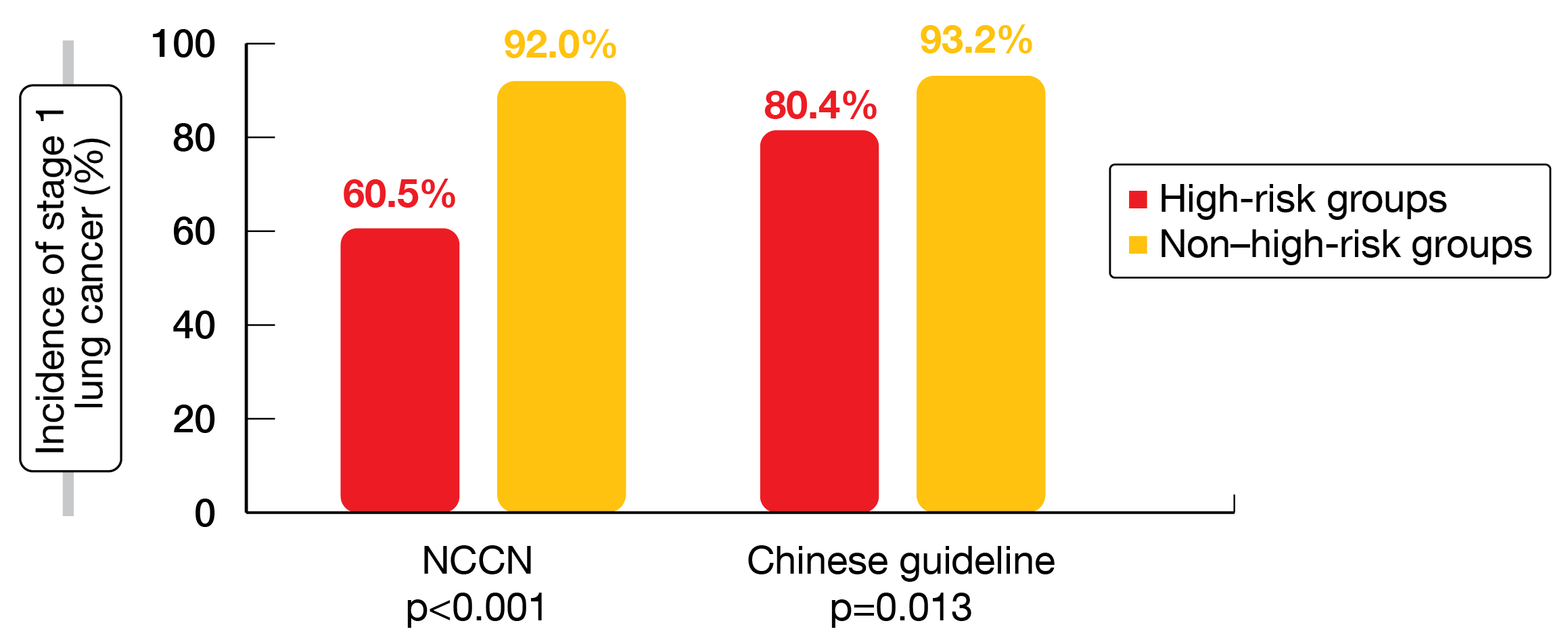Benefits of lung cancer mass screening in China
The LUNG-CARE project presented by Liang et al. aimed to evaluate the outcome of mass lung cancer screening in a Chinese general population and to investigate risk factors to improve risk assessment for screening [1]. This was based on the consideration that screening should not be restricted to smokers in Asia as lung cancer in women and non-smokers is more common than in Europe and the United States. Between 2017 and 2021, residents of Guangzhou aged 40-74 years who accepted to undergo one-off low-dose computed tomography (LDCT) were eligible. Exclusion criteria comprised a diagnosis of lung cancer or treatment related to lung cancer within the past 5 years, previous chest CT within the past year and significant cancer-related symptoms such as hemoptysis and dyspnea. The primary objective was the prevalence of lung cancer in the general population of Guangzhou.
Mortality reduction by 63 %
A total of 12,644 individuals were assessed for eligibility, and 11,708 completed LDCT screening. Solid or subsolid nodules sized ≥ 5 mm or pure ground glass nodules ≥ 8 mm were detected in 2,245 persons, resulting in a detection rate of 19.2 %. Invasive diagnostic procedures including surgery followed in 230 cases. Overall, pathologically confirmed lung cancers were detected in 1.7 %, with 86.0 % of these patients staged as 0 or 1. The incidence of lung cancer increased with age and showed a peak in the group aged 60-64. At the same time, the proportion of stage 1 disease decreased. This was in line with previous results from a population level analysis [2].
Compared to the unscreened control group from the same community that comprised approximately 110,000 individuals, LDCT screening increased the survival probability of lung cancer patients, with a 63 % relative risk reduction (HR, 0.37; p < 0.001). This was much higher than the risk reduction observed in the China National Lung Cancer Screening program that had been conducted in individuals classified to be at high risk according to a sex-specific risk score (HR, 0.69) [3]. The authors attributed this difference to the inclusion of non–high-risk individuals. Lung cancer prognosis was consistently better in the screened group compared to the unscreened group, which was probably due to the higher proportion of patients with early-stage disease.
Cancer cases irrespective of established risk factors
Within the group of lung cancer patients identified by mass screening, only 19.6 % and 55.6 % met the high-risk criteria defined by the NCCN guideline and the Chinese guideline, respectively [4, 5]. Therefore, upfront restriction to the group with established high-risk features would have led to missing a large proportion of cases. Detection rates were similar across people defined as high-risk and non–high-risk according to the NCCN guideline (2.0 % vs. 1.6 %; p = 0.245). According to the Chinese guideline, the detection rate was higher in the high-risk group, although it was considerable even in the non–high-risk group (2.3 % vs. 1.3 %; p < 0.001). Moreover, surprisingly, stage 1 lung cancer occurred significantly more often in non–high-risk individuals than in the high-risk cohorts according to both guidelines (Figure).
Using a Markov model, the scientists demonstrated that mass screening is cost-effective, with incremental cost effectiveness ratios averaging 14,002 $ per quality-adjusted life year. While the total cost of screening and the ensuing treatments amounted to 6.18 million $, the total benefit of this strategy was estimated at 36.5 million $.
In order to expand the current criteria, the authors identified risk factors that had been collected based on questionnaires. Multivariate analyses identified the following independent risk factors: personal cancer history, exposure to silicon dioxide, older age, food allergy, history of asthma, and family history of lung cancer. An integrated prediction model yielded an AUC of 0.71, which was higher than the AUCs for the criteria used in the NCCN and Chinese guidelines (0.52 and 0.62, respectively). The authors concluded that the risk assessment for lung cancer screening can be improved based on a risk prediction model including these characteristics combined with CEA that was also significantly elevated.
Figure: Incidence of stage 1 lung cancers in the screened population stratified by risk criteria according to the NCCN and Chinese guidelines
REFERENCES
- Liang W et al., Community-based mass screening with low-dose CT for lung cancer in Guangzhou. ESMO 2022, abstract LB48
- Li C et al., Optimal starting age for lung cancer screening with low-dose computed tomography: a population level analysis. J Thorac Oncol 2019; 14(4): e82-e84
- Li N et al., One-off low-dose CT for lung cancer screening in China: a multicentre, population-based, prospective cohort study. Lancet Respir Med 2022; 10(4): 378-391
- Wood D et al., NCCN Guidelines® Insights: Lung Cancer Screening, Version 1.2022. J Natl Compr Canc Netw 2022; 20(7): 754-764
- Han B et al., Oncology Society of Chinese Medical Association guideline for clinical diagnosis and treatment of lung cancer (2021 edition). Zhonghua Zhong Liu Za Zhi 2021; 43(6): 591-621
© 2022 Springer-Verlag GmbH, Impressum
More posts
Preface – ESMO Lung Cancer 2022
Preface – ESMO Lung Cancer 2022 © ElainePerks2013 - Charles Swanton, MBBS, PhD, FRCP, F





